Dust Transport from Inland Australia and Its Impact on Air Quality and Health on the Eastern Coast of Australia during the February 2019 Dust Storm
Abstract
1. Introduction
2. Data and Methods
2.1. Dust Emission Model
2.2. WRF-Chem Configuration
2.3. Emission Data
2.4. Impact of Dust on Health
3. Results
3.1. Impact on Air Quality: WRF-Chem Prediction of PM2.5 and PM10
3.2. Impact on Health
3.2.1. Mortality Impact
3.2.2. Respiratory Diseases Hospitalisation
3.2.3. Cardiac Diseases Hospitalisation
4. Discussion
5. Conclusions
Supplementary Materials
Author Contributions
Funding
Data Availability Statement
Acknowledgments
Conflicts of Interest
References
- Middleton, N. Desert dust hazards: A global review. Aeolian Res. 2017, 24, 53–63. [Google Scholar] [CrossRef]
- Chan, Y.; McTainsh, G.; Leys, J.; McGowan, H.; Tews, E. Influence of the 23 October 2002 dust storm on the air quality of four Australian cities. Water Air Soil Pollut. 2005, 164, 329–348. [Google Scholar] [CrossRef]
- Leys, J.; Heidenreich, S.; Strong, C.; McTainsh, G.; Quigley, S. PM10 concentrations and mass transport during “Red Dawn”—Sydney 23 September 2009. Aeolian Res. 2011, 3, 327–342. [Google Scholar] [CrossRef]
- Raupach, M.; McTainsh, G.; Leys, J. Estimates of dust mass in recent major dust storms. Aust. J. Soil Water Conserv. 1994, 7, 20–24. [Google Scholar]
- Gorbushina, A.; Kort, R.; Schulte, A.; Lazarus, D.; Schnetger, B.; Brumsack, H.; Broughton, W.J.; Favet, J. Life in Darwin’s dust: Intercontinental transport and survival of microbes in the nineteenth century. Environ. Microbiol. 2007, 9, 2911–2922. [Google Scholar] [CrossRef] [PubMed]
- Ke-Yi, C. The Northern Path of Asian Dust Transport from the Gobi Desert to North America. Atmos. Ocean. Sci. Lett. Daqi He Haiyang Kexue Kuaibao 2010, 3, 155–159. [Google Scholar] [CrossRef]
- Griffin, D.; Kellogg, C. Dust storms and their impact on ocean and human health: Dust in earth’s atmosphere. EcoHealth 2004, 1, 284–295. [Google Scholar] [CrossRef]
- Calvo, E.; Pelejero, C.; Logan, G.; de Deckker, P. Dust-induced changes in phytoplankton composition in the Tasman Sea during the last four glacial cycles. Paleoceanography 2004, 19. [Google Scholar] [CrossRef]
- Shaw, E.; Gabric, A.; McTainsh, G. Impacts of aeolian dust deposition on phytoplankton dynamics in Queensland coastal waters. Mar. Freshw. Res. 2008, 59, 951–962. [Google Scholar] [CrossRef]
- Bhattachan, A.; D’Odorico, P. Can land use intensification in the Mallee, Australia increase the supply of soluble iron to the Southern Ocean? Nat. Sci. Rep. 2014, 4, 6009. [Google Scholar] [CrossRef]
- Gabric, A.J.; Cropp, R.; McTainsh, G.; Butler, H.; Johnston, B.M.; O’Loingsigh, T.; van Tran, D. Tasman Sea biological response to dust storm events during the austral spring of 2009. Mar. Freshw. Res. 2016, 67, 1090–1102. [Google Scholar] [CrossRef]
- Garrison, V.; Majewski, M.; Foreman, W.; Genualdi, S.; Mohammed, A.; Simonich, S.M. Persistent organic contaminants in Saharan dust air masses in West Africa, Cape Verde and the eastern Caribbean. Sci. Total Environ. 2014, 468–469, 530–543. [Google Scholar] [CrossRef] [PubMed]
- Leys, J.; McTainsh, G. Dust and nutrient deposition to riverine environments of south-eastern Australia. Z. Geomorphol. Suppl. 1999, 116, 59–76. [Google Scholar]
- Lenes, J.; Prospero, J.; Landing, W.; Virmani, J.; Walsh, J. A model of Saharan dust deposition to the eastern Gulf of Mexico. Mar. Chem. 2012, 134–135, 1–9. [Google Scholar] [CrossRef]
- Braun-Fahrlander, C.; Riedler, J.; Herz, U.; Eder, W.; Waser, M.; Grize, L.; Maisch, S.; Carr, D.J.J.; Gerlach, F.; Bufe, A.; et al. Environmental exposure to endotoxin and its relation to asthma in school-age children. N. Engl. J. Med. 2002, 347, 869–877. [Google Scholar] [CrossRef]
- McTainsh, G.; Chan, Y.; McGowan, H.; Leys, J.; Tews, K. The 23rd October 2002 dust storm in eastern Australia: Characteristics and meteorological conditions. Atmos. Environ. 2005, 39, 1227–1236. [Google Scholar] [CrossRef]
- Reynolds, R.; Cattle, S.; Moskowitz, B.; Goldstein, H.; Yauk, K.; Flagg, C.; Berquó, T.; Kokaly, R.; Morman, S.; Breit, G. Iron oxide minerals in dust of the Red Dawn event in eastern Australia, September 2009. Aeolian Res. 2014, 15, 1–13. [Google Scholar] [CrossRef]
- Rutherford, S.; Clark, E.; McTainsh, G.; Simpson, R.; Mitchell, C. Characteristics of rural dust events shown to impact on asthma severity in Brisbane, Australia. Int. J. Biometeorol. 1999, 42, 217–225. [Google Scholar] [CrossRef]
- Johnston, F.; Hanigan, I.; Henderson, S.; Morgan, G.G.; Bowman, D. Extreme air pollution events from bushfires and dust storms and their association with mortality in Sydney, Australia 1994–2007. Environ. Res. 2011, 111, 811–816. [Google Scholar] [CrossRef]
- Merrifield, A.; Schindeler, S.; Jalaludin, B.; Smith, W. Health effects of the September 2009 dust storm in Sydney, Australia: Did emergency department visits and hospital admissions increase? Environ. Health 2013, 12, 32. [Google Scholar] [CrossRef]
- Bener, A.; Abdulrazzaq, Y.; Al-Mutawwa, J.; Debuse, P. Genetic and environmental factors associated with asthma. Hum. Biol. 1996, 68, 405–414. [Google Scholar] [PubMed]
- Khaniabadi, Y.; Daryanoosh, S.; Amrane, A.; Polosa, R.; Hopke, P.K.; Goudarzi, G.; Mohammadi, M.J.; Sicard, P.; Armin, H. Impact of Middle Eastern Dust storms on human health. Atmos. Pollut. Res. 2017, 8, 606–613. [Google Scholar] [CrossRef]
- Thalib, L.; Al-Taiar, A. Dust storms and the risk of asthma admissions to hospitals in Kuwait. Sci. Total Environ. 2012, 433, 347–351. [Google Scholar] [CrossRef] [PubMed]
- Kim, H.; Kim, D.; Kim, H.; Yi, S. Relationship between mortality and fine particles during Asian dust, smog–Asian dust, and smog days in Korea. Int. J. Environ. Health Res. 2012, 22, 518–530. [Google Scholar] [CrossRef] [PubMed]
- Zhang, Q.; Zhang, J.; Yang, Z.; Zhang, Y.; Meng, Z. Impact of PM2.5 derived from dust events on daily outpatient numbers for respiratory and cardiovascular diseases in Wuwei, China. Procedia Environ. Sci. 2013, 18, 290–298. [Google Scholar] [CrossRef]
- Nguyen, H.; Riley, M.; Leys, J.; Salter, D. Dust Storm Event of February 2019 in Central and East Coast of Australia and Evidence of Long-Range Transport to New Zealand and Antarctica. Atmosphere 2019, 10, 653. [Google Scholar] [CrossRef]
- Rea, G.; Paton-Walsh, C.; Turquety, S.; Cope, M.; Griffith, D. Impact of the New South Wales fires during October 2013 on regional air quality in eastern Australia. Atmos. Environ. 2016, 131, 150–163. [Google Scholar] [CrossRef]
- Ma, S.; Zhang, X.; Gao, C.; Tong, D.Q.; Xiu, A.; Wu, G.; Cao, X.; Huang, L.; Zhao, H.; Zhang, S.; et al. Multi-model simulations of springtime dust storms in East Asia: Implications of an evaluation of four commonly used air quality models (CMAQ v5.2.1, CAMx v6.50, CHIMERE v2017r4, and WRF-Chem v3.9.1). Geosci. Model Dev. Discuss. 2019. [Google Scholar] [CrossRef]
- Chen, S.; Zhao, C.; Qian, Y.; Leung, L.R.; Huang, J.; Huang, Z.; Bi, J.; Zhang, W.; Shi, J.; Yang, L.; et al. Regional modeling of dust mass balance and radiative forcing over East Asia using WRF-Chem. Aeolian Res. 2014. [Google Scholar] [CrossRef]
- Chen, S.; Yan, T.; Zhang, X.; Zhang, G.; Feng, T.; Zhao, D.; Zang, Z.; Liao, S.; Ma, X.; Jiang, N.; et al. Dust modeling over East Asia during the summer of 2010 using the WRF-Chem model. J. Quant. Spectrosc. Radiat. Transf. 2018, 213, 1–12. [Google Scholar] [CrossRef]
- Segersson, D.; Eneroth, K.; Gidhagen, L.; Johnasson, C.; Omstedt, G.; Nylén, A.E.; Forsberg, B. Health Impact of PM10, PM2.5 and Black Carbon exposure due to different source sectors in Stockholm, Gothenburg and Umea, Sweden. Int. J. Environ. Res. Public Health 2017, 14, 742. [Google Scholar] [CrossRef] [PubMed]
- O’Loingsigh, T.; Chubb, T.; Baddock, M.; Kelly, T.; Tapper, N.J.; de Deckker, P.; McTainsh, G. Sources and pathways of dust during the Australian “Millennium Drought” decade. J. Geophys. Res. Atmos. 2017, 122, 1246–1260. [Google Scholar] [CrossRef]
- Ginoux, P.; Chin, M.; Tegen, I.; Prospero, J.M.; Holben, B.; Dubovik, O.; Lin, S.-J. Sources and distributions of dust aerosols simulated with the GOCART model. J. Geophys. Res. Atmos. 2001, 106, 20255–20273. [Google Scholar] [CrossRef]
- Marticorena, B.; Bergametti, G. Modeling the atmospheric dust cycle. Part 1: Design of a soil-derived dust emission scheme. J. Geophys. Res. Atmos. 1995, 100, 16415–16430. [Google Scholar] [CrossRef]
- Marticorena, B.; Bergametti, G.; Aumont, B.; Callot, Y.; N’Doumé, C.; Legrand, M. Modeling the atmospheric dust cycle: 2. Simulation of Saharan dust sources. J. Geophys. Res. Atmos. 1997, 102, 4387–4404. [Google Scholar] [CrossRef]
- LeGrand, S.; Polashenski, C.; Letcher, T.; Creighton, G.A.; Peckham, S.E.; Cetola, J.D. The AFWA dust emission scheme for the GOCART aerosol model in WRF-Chem v3.8.1. Geosci. Model Dev. 2019, 12, 131–166. [Google Scholar] [CrossRef]
- Crippa, P.; Castruccio, S.; Archer-Nicholls, S.; Lebron, G.B.; Kuwata, M.; Thota, A.; Sumin, S.; Butt, E.; Wiedinmyer, C.; Spracklen, D.V. Population exposure to hazardous air quality due to the 2015 fires in Equatorial Asia. Sci. Rep. 2016, 6, 37074. [Google Scholar] [CrossRef]
- Archer-Nicholls, S.; Carter, E.; Kumar, R.; Xiao, Q.; Liu, Y.; Frostad, J.; Forouzanfar, M.H.; Cohen, A.; Brauer, M.; Baumgartner, J.; et al. The Regional Impacts of Cooking and Heating Emissions on Ambient Air Quality and Disease Burden in China. Environ. Sci. Technol. 2016, 50, 9416–9423. [Google Scholar] [CrossRef]
- Hvidtfeldt, U.; Sørensen, M.; Geels, C.; Ketzel, M.; Khan, J.; Tjønneland, A.; Overvad, K.; Brandt, J.; Raaschou-Nielsen, O. Long-term residential exposure to PM2.5, PM10, black carbon, NO2, and ozone and mortality in a Danish cohort. Environ. Int. 2019, 123, 265–272. [Google Scholar] [CrossRef]
- Liu, C.; Chen, R.; Sera, F.; Vicedo-Cabrera, A.; Guo, Y.; Tong, S.; Coelho, M.S.; Saldiva, P.H.; Lavigne, E.; Matus, P.; et al. Ambient particulate air pollution and daily mortality in 652 Cities. N. Engl. J. Med. 2019, 381, 705–715. [Google Scholar] [CrossRef]
- WHO (World Health Organization). Health Risks of Air Pollution in Europe—HRAPIE Project Recommendations for Concentration–Response Functions for Cost–Benefit Analysis of Particulate Matter, Ozone and Nitrogen Dioxide. 2013. Available online: https://www.euro.who.int/__data/assets/pdf_file/0006/238956/Health_risks_air_pollution_HRAPIE_project.pdf (accessed on 22 January 2021).
- Delfino, R.J.; Brummel, S.; Wu, J.; Stern, H.; Ostro, B.; Lipsett, M.; Winer, A.; Street, D.H.; Zhang, L.; Tjoa, T.; et al. The relationship of respiratory and cardiovascular hospital admissions to the southern California wildfires of 2003. Occup. Environ. Med. 2009, 66. [Google Scholar] [CrossRef] [PubMed]
- Horsley, J.; Broome, R.; Johnston, F.; Cope, M.; Morgan, G. Health burden associated with fire smoke in Sydney, 2001–2013. Med. J. Aust. 2018, 208, 309–310. [Google Scholar] [CrossRef] [PubMed]
- Nguyen, H.; Trieu, T.; Cope, M.; Azzi, M.; Morgan, G. Modelling Hazardous Reduction Burnings and Bushfire Emission in Air Quality Model and Their Impacts on Health in the Greater Metropolitan Region of Sydney. Environ. Modeling Assess. 2020, 25. [Google Scholar] [CrossRef]
- Baddock, M.C.; Parsons, K.; Strong, C.L.; Leys, J.F.; McTainsh, G.H. Drivers of Australian dust: A case study of frontal winds and dust dynamics in the lower Lake Eyre Basin. Earth Surf. Process. Landf. 2015, 40, 1982–1988. [Google Scholar] [CrossRef]
- Leys, J.; Strong, C.; Heidenreich, S.; Koen, K. Where She Blows! A Ten Year Dust Climatology of Western New South Wales Australia. Geosciences 2018, 8, 232. [Google Scholar] [CrossRef]
- Rizza, U.; Bernaba, F.; Miglietta, M.; Mangia, C.; di Liberto, L.; Dionisi, D.; Costabile, F.; Grasso, F.; Gobbi, G.P. WRF-Chem model simulations of a dust outbreak over the central Mediterranean and comparison with multi-sensor desert dust observations. Atmos. Chem. Phys. 2017, 17, 93. [Google Scholar] [CrossRef]
- Chaibou, A.; Ma, X.; Kumar, K.; Jia, H. Evaluation of dust extinction and vertical profiles simulated by WRF-Chem with CALIPSO and AREONET over North Africa. J. Atmos. Sol. Terr. Phys. 2019, 199, 105213. [Google Scholar] [CrossRef]
- Nikfal, A.; Raadatabadi, A.; Sehatkashani, S. Investigation of dust schemes in the model WRF/Chem. J. Air Pollut. Health 2018, 3, 1–8. [Google Scholar]
- Nabavi, S.; Haimberger, L.; Samini, C. Sensitivity of WRF-chem predictions to dust source function specification in West Asia. Aeolian Res. 2017, 24, 115–131. [Google Scholar] [CrossRef]
- Letcher, T.; Legrand, S. A comparison of simulated dust produced by three dust-emission schemes in WRF-Chem: Case-study assessment. Environ. Sci. 2018. [Google Scholar] [CrossRef]
- Cuchiara, G.; Rappenglück, B.; Rubio, M.; Lissi, E.; Gramsch, E.; Garreaud, R. Modeling study of biomass burning plumes and their impact on urban air quality; a case study of Santiago de Chile. Atmos. Environ. 2017, 166, 79–91. [Google Scholar] [CrossRef]
- Al-Taiar, A.; Thalib, L. Short-term effect of dust storms on the risk of mortality due to respiratory, cardiovascular and all-causes in Kuwait. Int. J. Biometeorol. 2014, 58, 69–77. [Google Scholar] [CrossRef] [PubMed]
- Barnett, A.; Fraser, J.; Munck, L. The effects of the 2009 dust storm on emergency admissions to a hospital in Brisbane, Australia. Int. J. Biometeorol. 2012, 56, 719–726. [Google Scholar] [CrossRef] [PubMed]
- Bennett, C.; McKendry, I.; Kelly, S. Impact of the 1998 Gobi dust event on hospital admissions in the Lower Fraser Valley, British Columbia. Sci. Total Environ. 2006, 366, 918–925. [Google Scholar] [CrossRef]
- Ostro, B.; Hurley, S.; Lipsett, M. Air pollution and daily mortality in the Coachella Valley, California: A study of PM10 dominated by coarse particles. Environ. Res. 1999, 81, 231–238. [Google Scholar] [CrossRef]
- Schwartz, J.; Norris, G.; Larson, T.; Sheppard, L.; Claiborne, C.; Koenig, J. Episodes of high coarse particle concentrations are not associated with increased mortality. Environ. Health Perspect. 1999, 107, 339–342. [Google Scholar] [CrossRef]
- Zhang, X.; Zhao, L.; Tong, D.; Wu, G.; Dan, M.; Teng, B. A systematic review of global desert dust and associated human health effects. Atmosphere 2016, 7, 158. [Google Scholar] [CrossRef]
- Relvas, H.; Miranda, A.; Carnevale, C.; Maffeis, G.; Turrini, E.; Volta, M. Optimal air quality policies and health: A multi-objective nonlinear approach. Environ. Sci. Pollut. Res. 2017, 24, 13687–13699. [Google Scholar] [CrossRef]
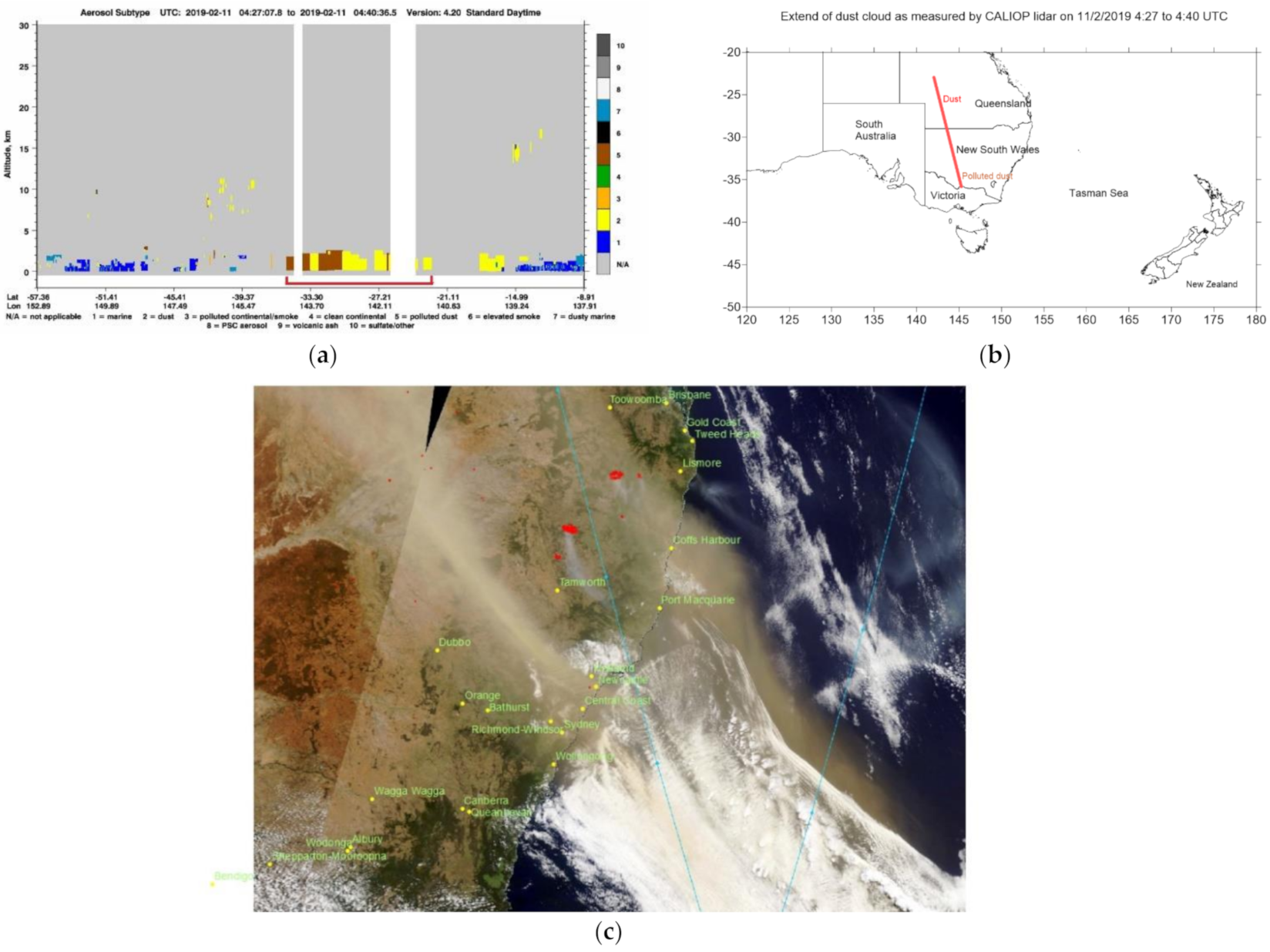
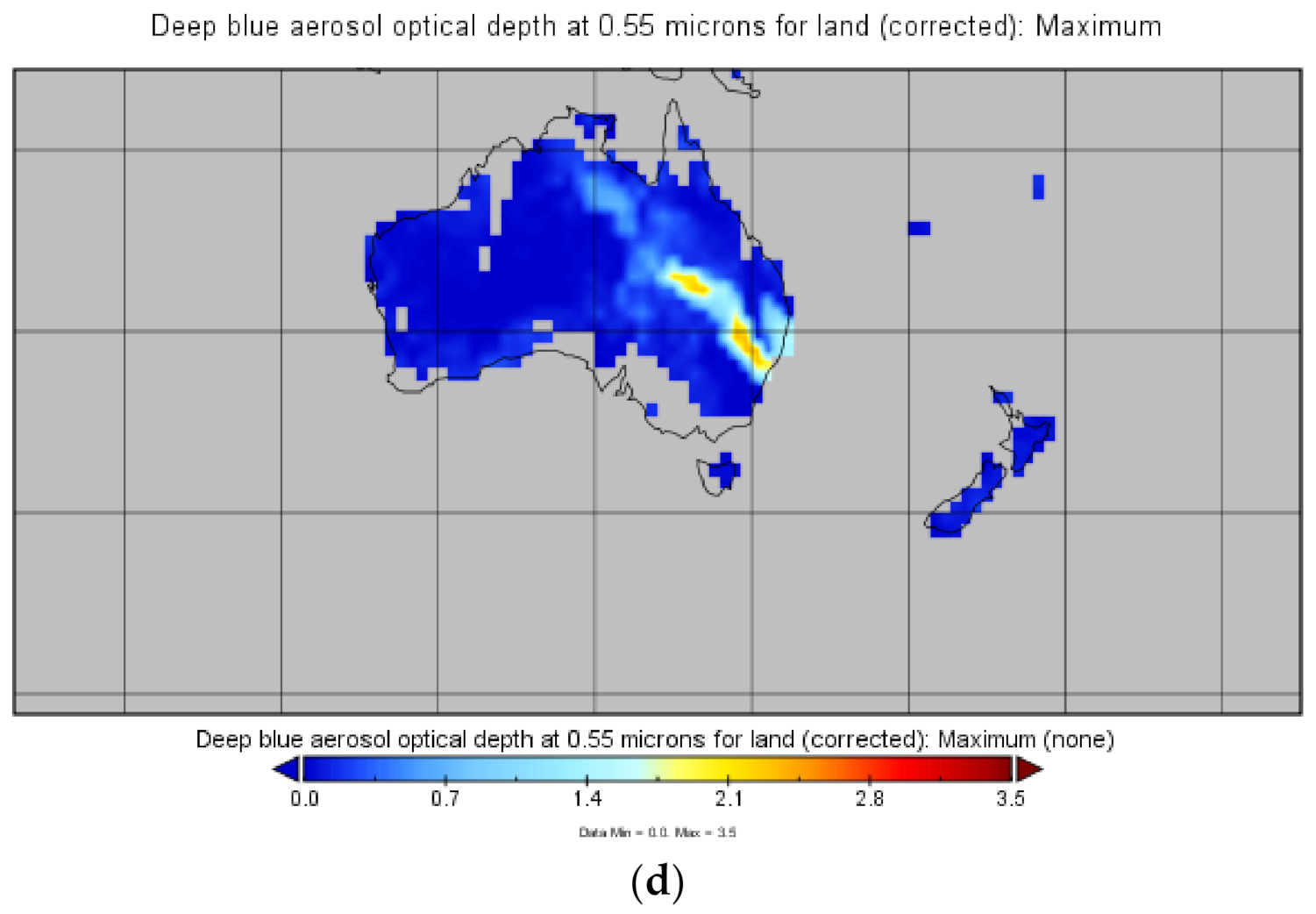
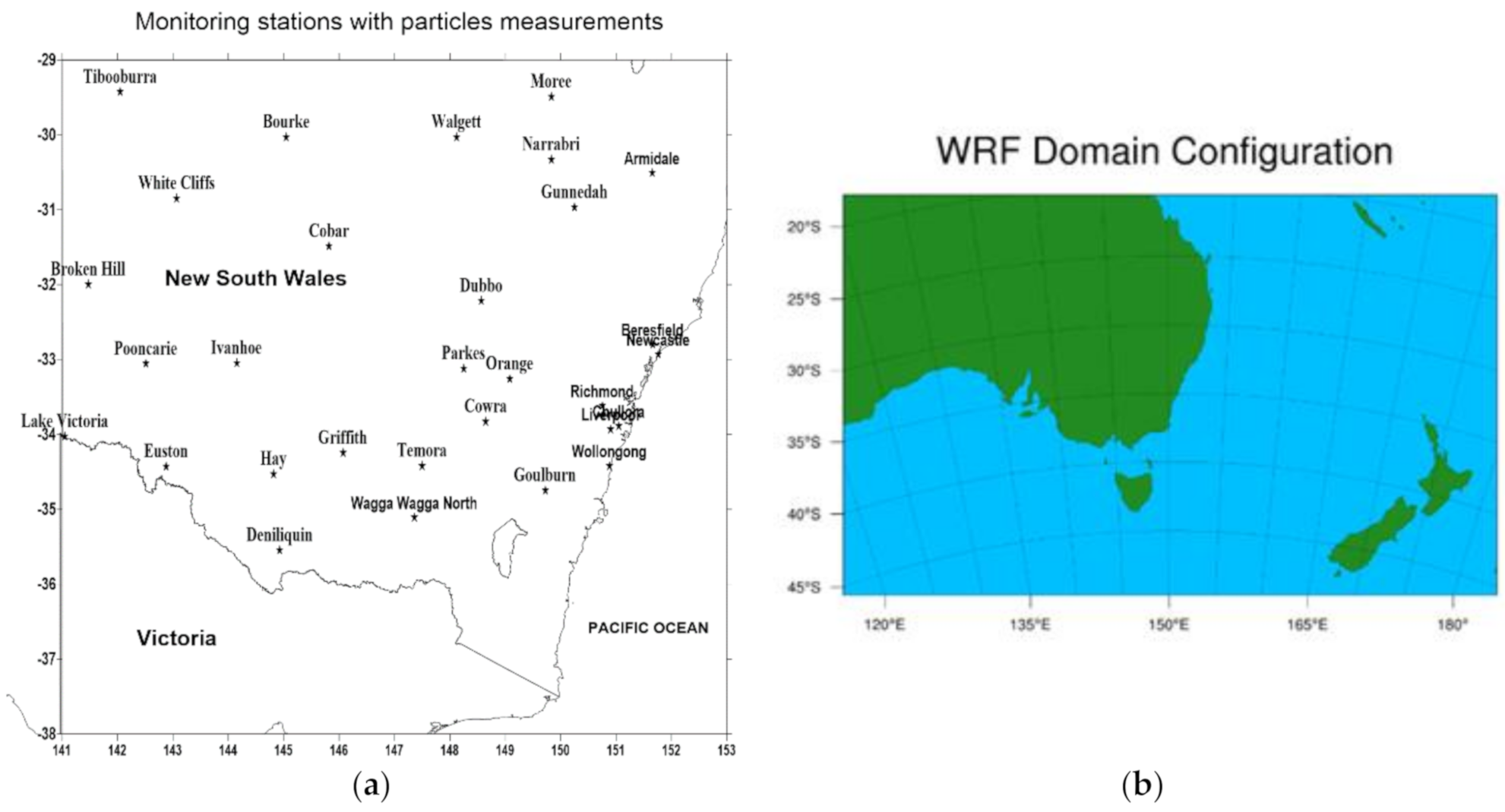
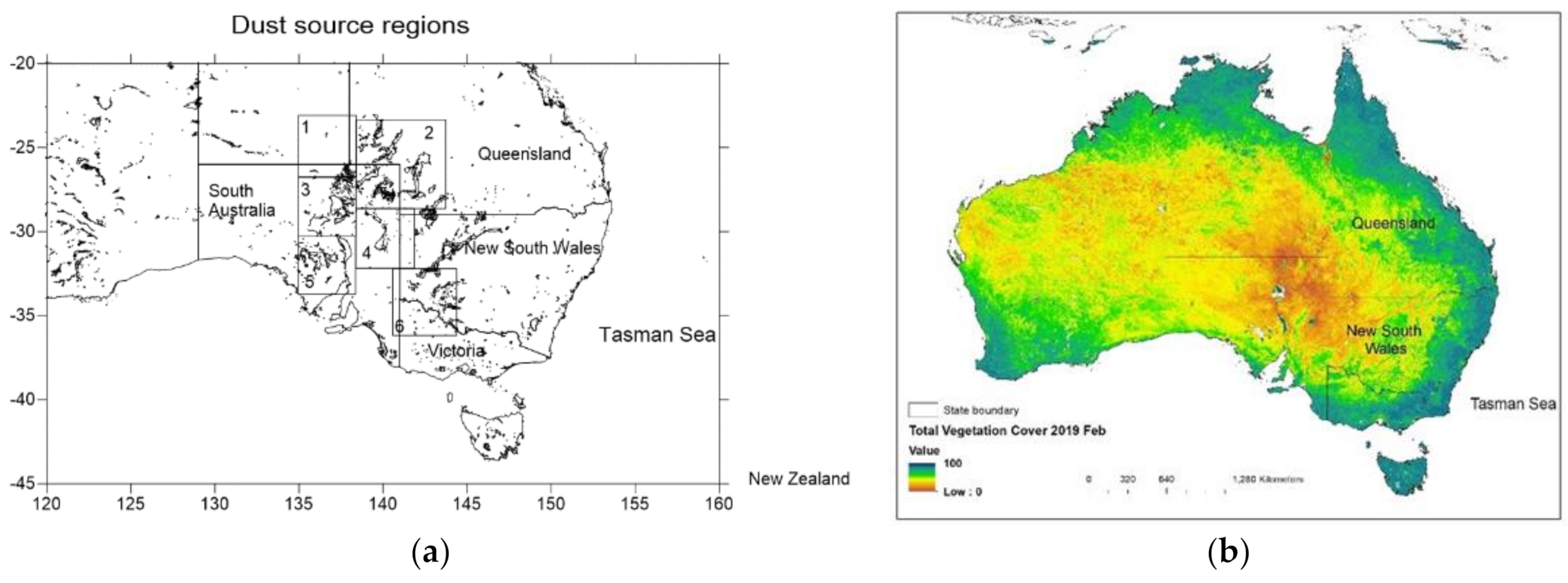
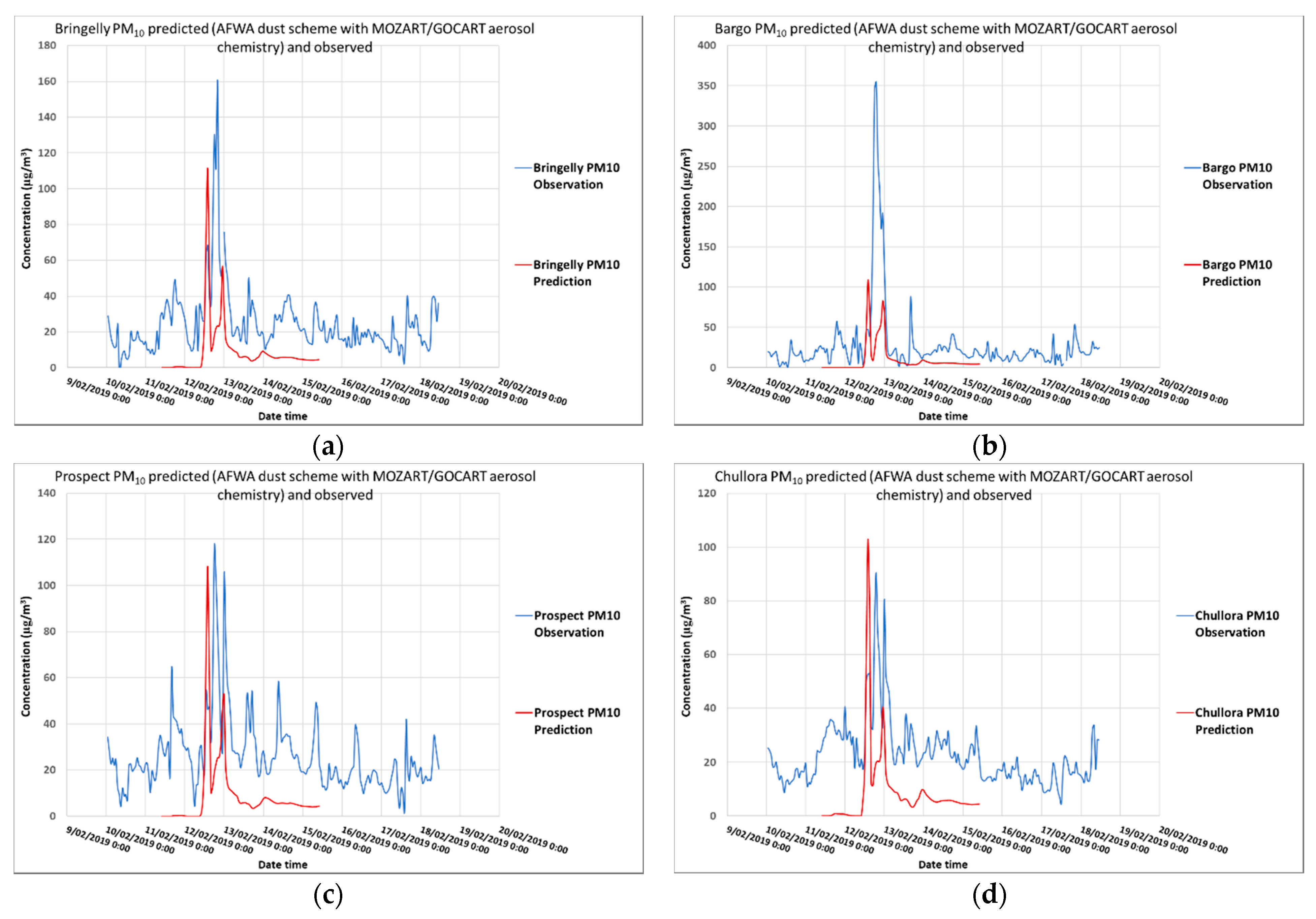
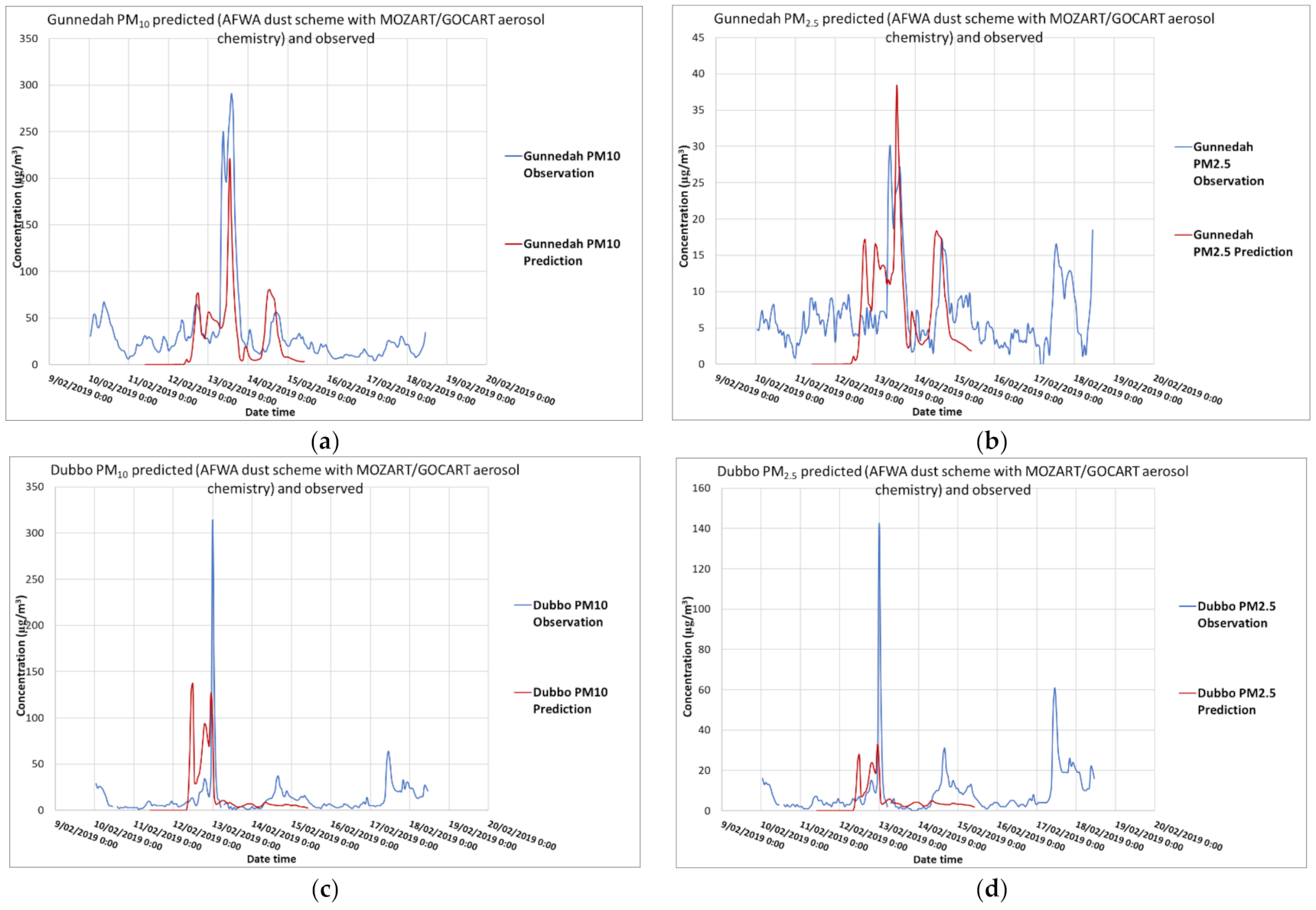
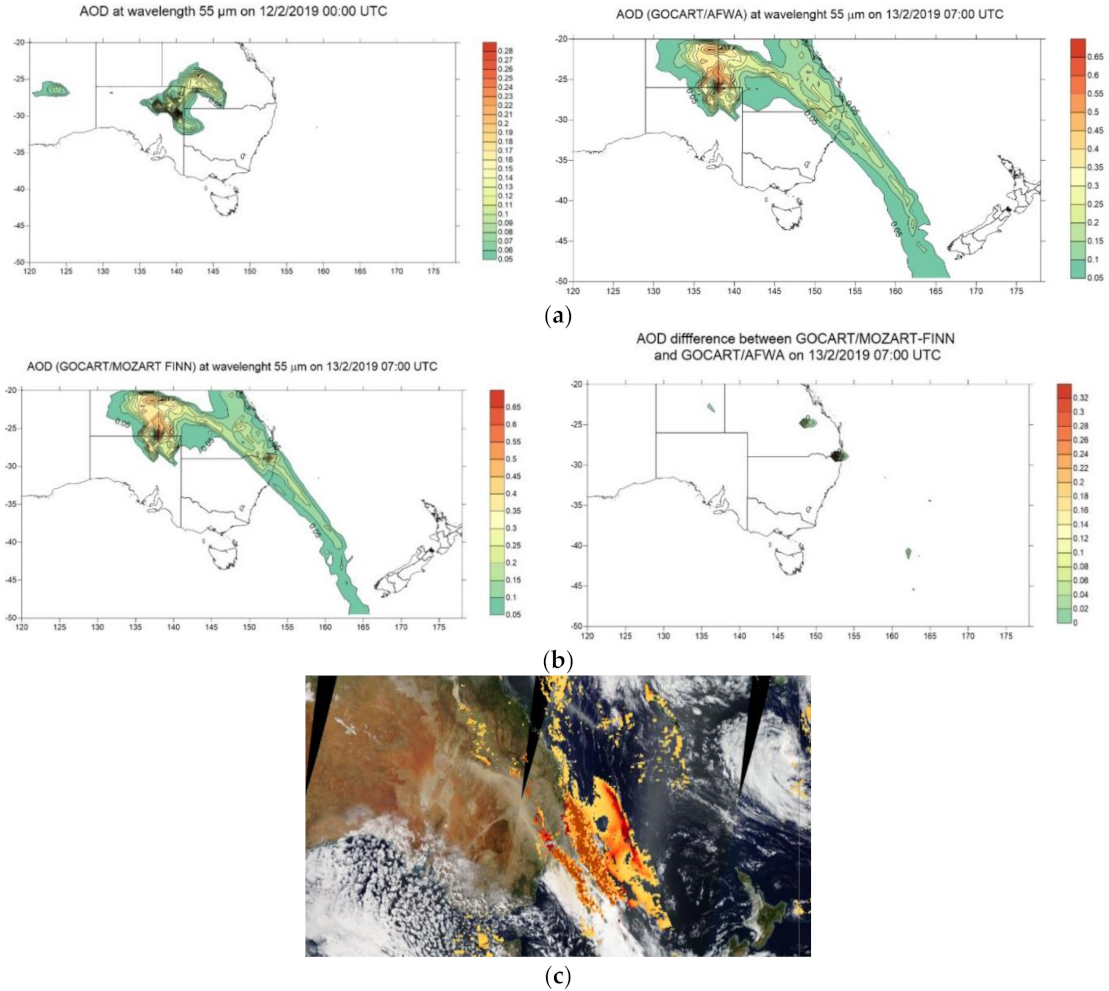
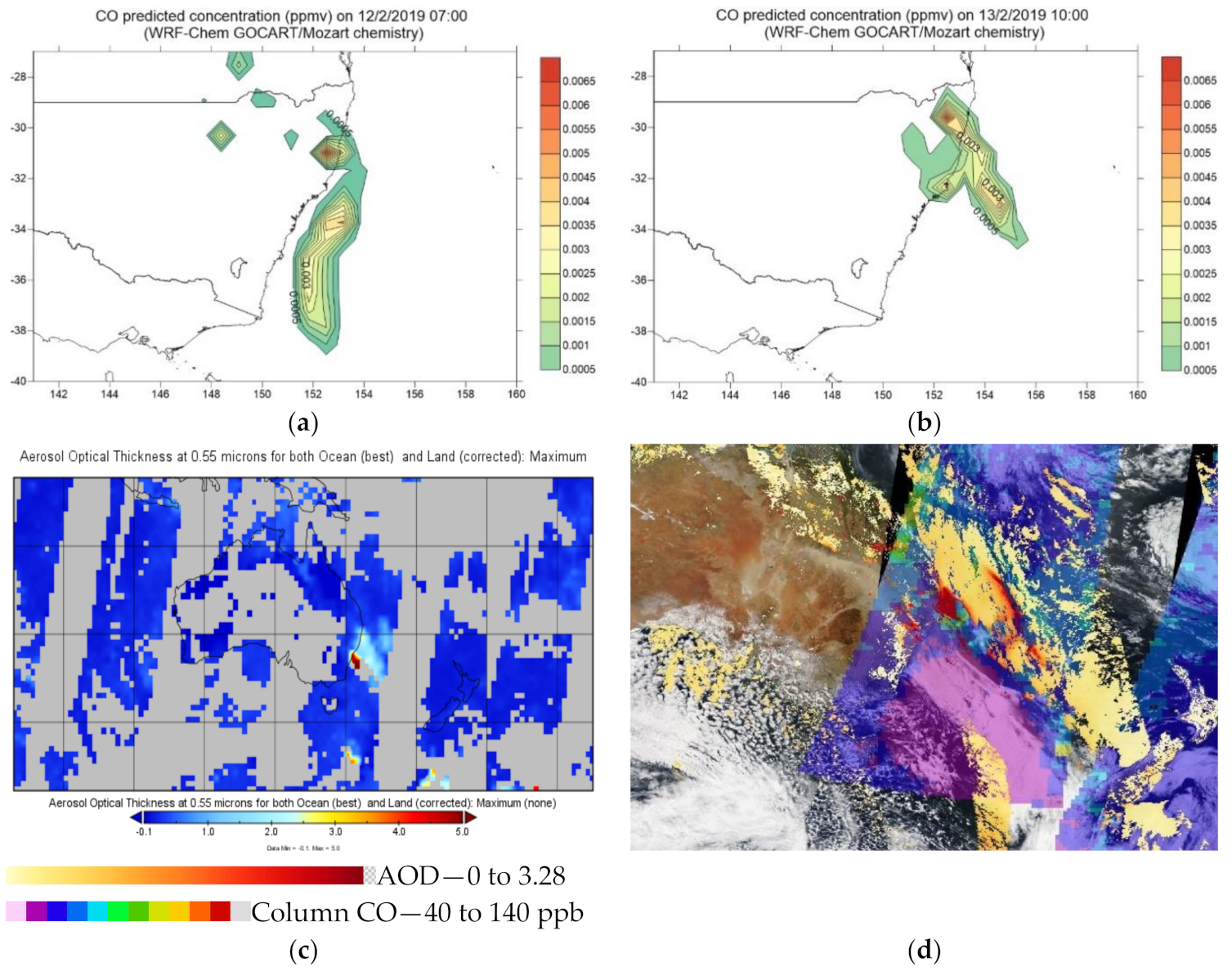
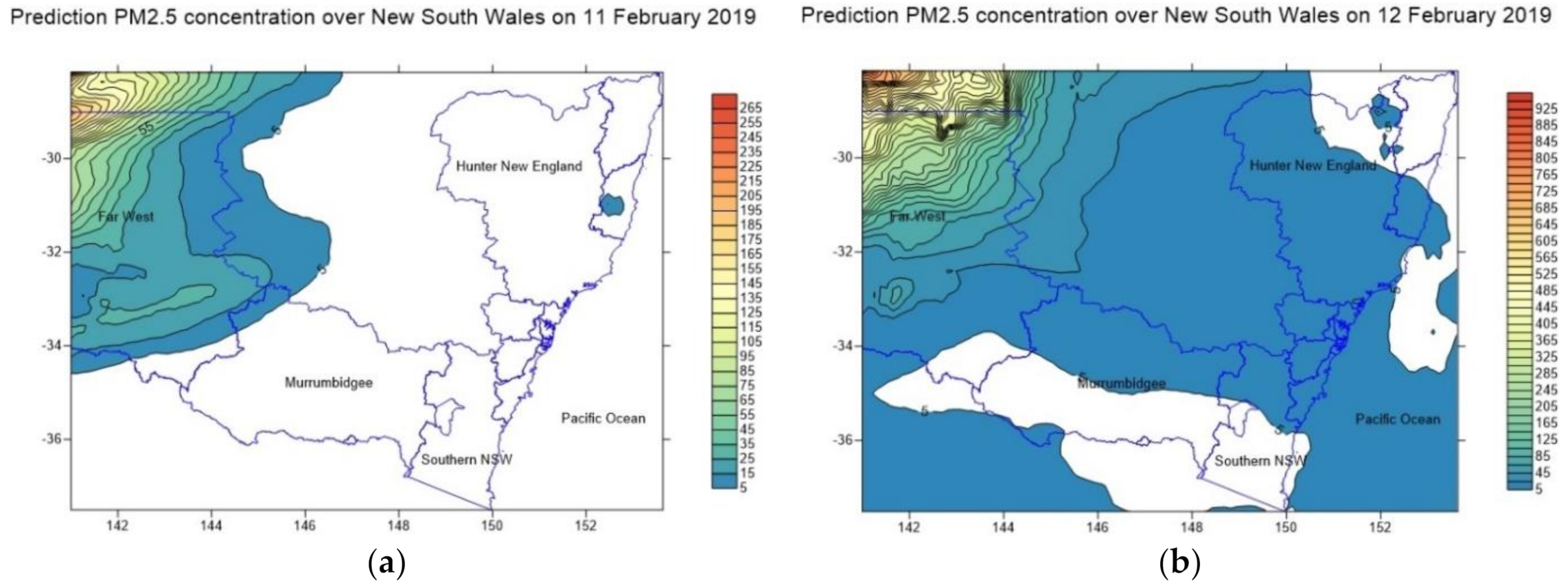
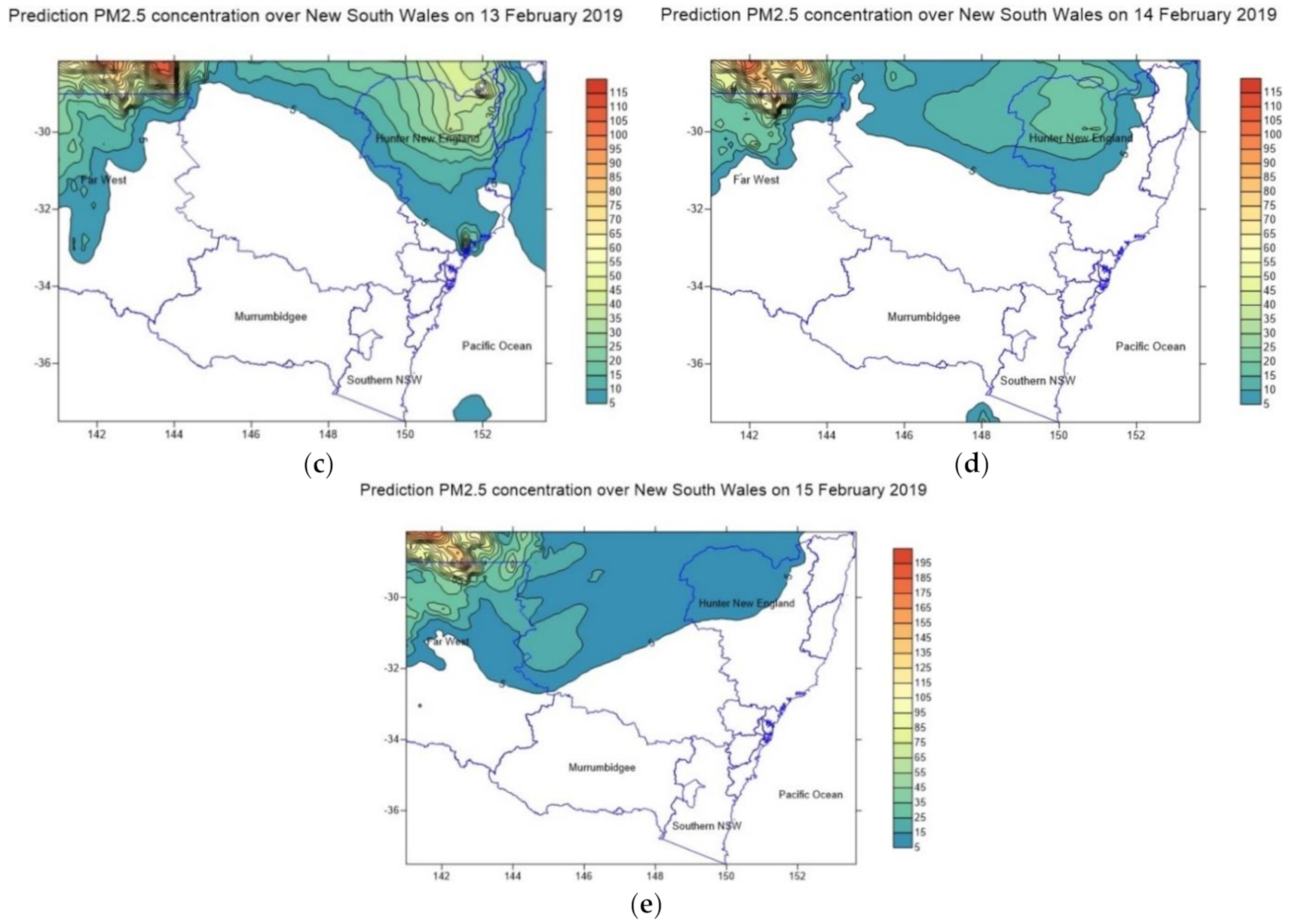
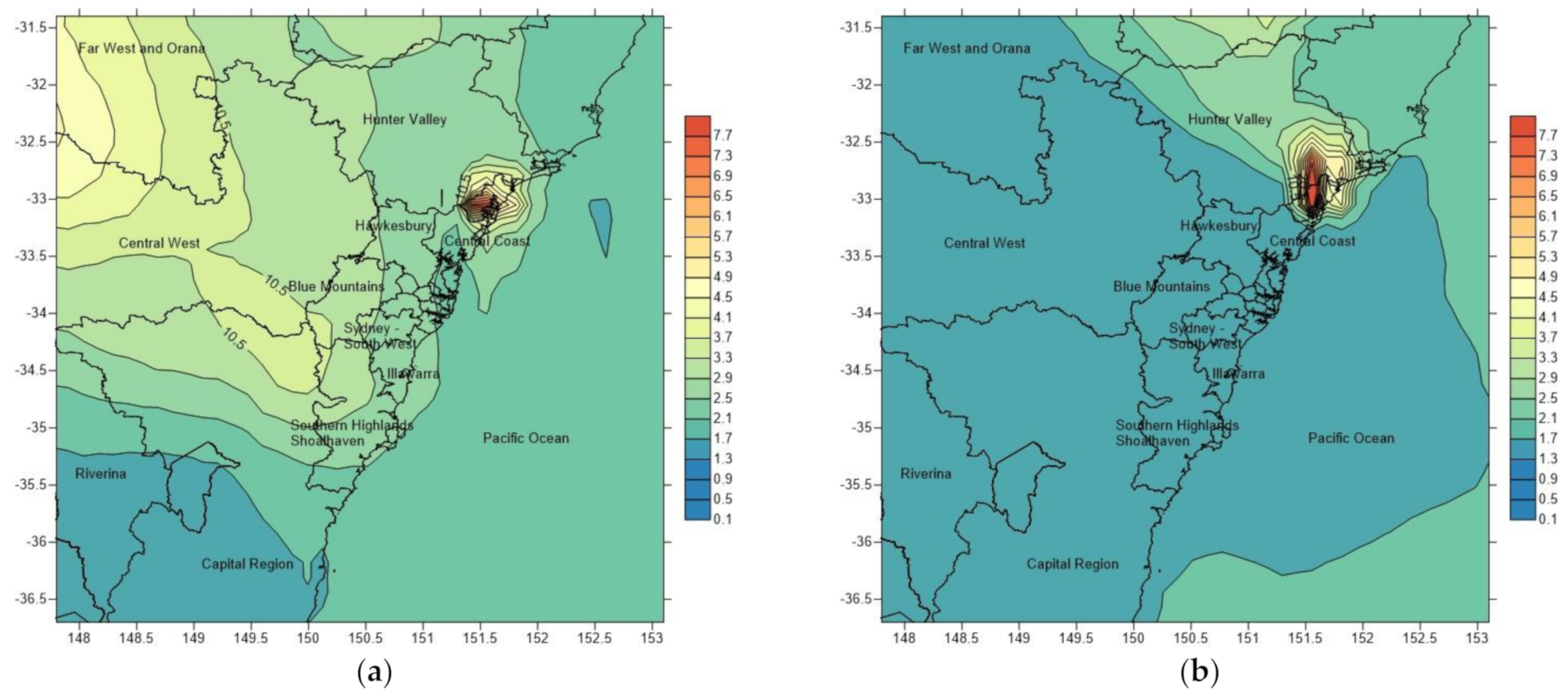
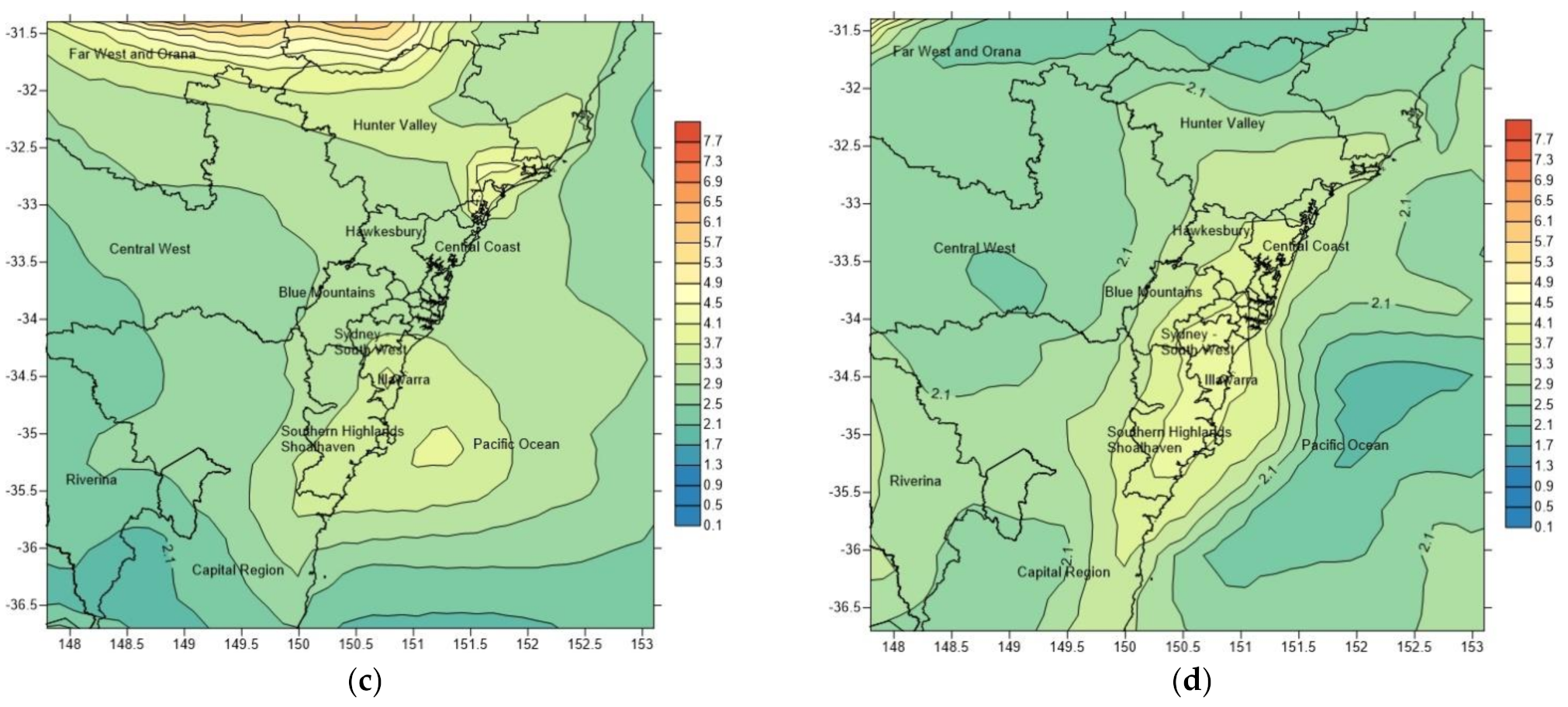
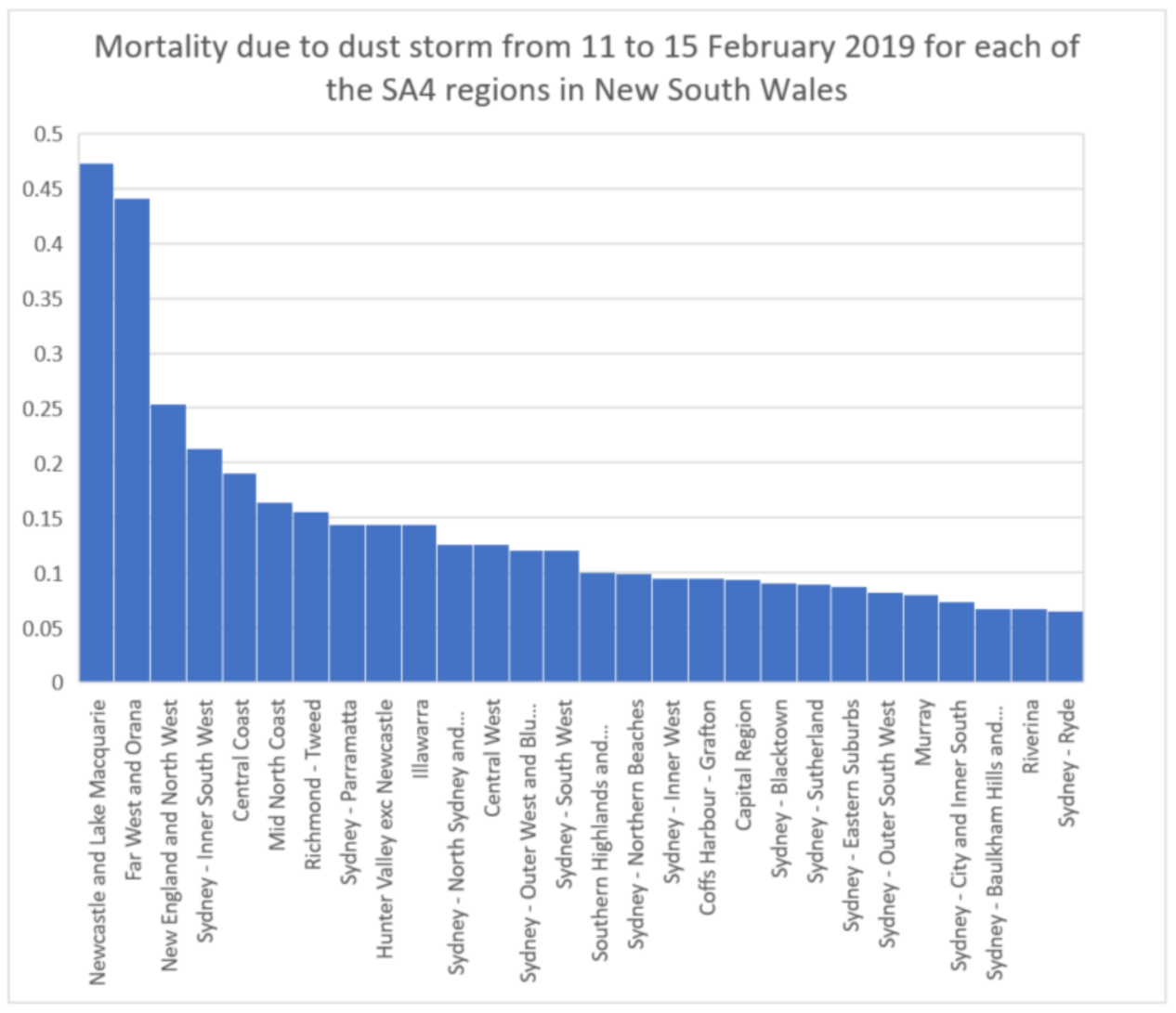
| SA4 Name | Population | 5-Days PM2.5 Mean of Daily Mean (µg/m3) | Attrib_mort_lci | Attrib_mort_mean | Attrib_mort_uci |
|---|---|---|---|---|---|
| Central Coast | 335,309 | 3.45 | 0.07 | 0.19 | 0.31 |
| Sydney—Baulkham Hills and Hawkesbury | 235,083 | 3.42 | 0.02 | 0.07 | 0.11 |
| Sydney—Blacktown | 350,356 | 3.38 | 0.03 | 0.09 | 0.15 |
| Sydney—City and Inner South | 337,069 | 3.29 | 0.03 | 0.07 | 0.12 |
| Sydney—Eastern Suburbs | 285,418 | 3.28 | 0.03 | 0.09 | 0.14 |
| Sydney—Inner South West | 598,454 | 3.41 | 0.08 | 0.21 | 0.35 |
| Sydney—Inner West | 308,268 | 3.37 | 0.03 | 0.10 | 0.16 |
| Sydney—North Sydney and Hornsby | 424,906 | 3.28 | 0.05 | 0.13 | 0.21 |
| Sydney—Northern Beaches | 266,344 | 3.26 | 0.04 | 0.10 | 0.16 |
| Sydney—Outer South West | 269,272 | 3.60 | 0.03 | 0.08 | 0.13 |
| Sydney—Outer West and Blue Mountains | 314,848 | 3.75 | 0.04 | 0.12 | 0.20 |
| Sydney—Parramatta | 467,161 | 3.39 | 0.05 | 0.14 | 0.24 |
| Sydney—Ryde | 190,161 | 3.32 | 0.02 | 0.07 | 0.11 |
| Sydney—South West | 421,692 | 3.54 | 0.04 | 0.12 | 0.20 |
| Sydney—Sutherland | 225,427 | 3.42 | 0.03 | 0.09 | 0.15 |
| Hunter Valley exc Newcastle | 269,668 | 4.26 | 0.05 | 0.14 | 0.23 |
| Illawarra | 303,701 | 3.64 | 0.05 | 0.14 | 0.23 |
| Newcastle and Lake Macquarie | 370,182 | 8.25 | 0.17 | 0.47 | 0.77 |
| Capital Region | 224,288 | 2.89 | 0.03 | 0.09 | 0.15 |
| Central West | 210,762 | 4.02 | 0.05 | 0.13 | 0.21 |
| Coffs Harbour—Grafton | 138,904 | 4.26 | 0.03 | 0.09 | 0.16 |
| Far West and Orana | 116,795 | 22.89 | 0.16 | 0.44 | 0.73 |
| Mid North Coast | 216,002 | 3.77 | 0.06 | 0.16 | 0.27 |
| Murray | 117,783 | 4.38 | 0.03 | 0.08 | 0.13 |
| New England and North West | 185,787 | 9.06 | 0.09 | 0.25 | 0.41 |
| Richmond—Tweed | 245,164 | 3.82 | 0.06 | 0.16 | 0.25 |
| Riverina | 159,794 | 3.03 | 0.02 | 0.07 | 0.11 |
| Southern Highlands and Shoalhaven | 150,676 | 3.62 | 0.04 | 0.10 | 0.16 |
| All SA4 regions | 7,739,274 | 4.61 (*) | 1.46 | 4.00 | 6.54 |
Publisher’s Note: MDPI stays neutral with regard to jurisdictional claims in published maps and institutional affiliations. |
© 2021 by the authors. Licensee MDPI, Basel, Switzerland. This article is an open access article distributed under the terms and conditions of the Creative Commons Attribution (CC BY) license (http://creativecommons.org/licenses/by/4.0/).
Share and Cite
Aragnou, E.; Watt, S.; Nguyen Duc, H.; Cheeseman, C.; Riley, M.; Leys, J.; White, S.; Salter, D.; Azzi, M.; Tzu-Chi Chang, L.; et al. Dust Transport from Inland Australia and Its Impact on Air Quality and Health on the Eastern Coast of Australia during the February 2019 Dust Storm. Atmosphere 2021, 12, 141. https://doi.org/10.3390/atmos12020141
Aragnou E, Watt S, Nguyen Duc H, Cheeseman C, Riley M, Leys J, White S, Salter D, Azzi M, Tzu-Chi Chang L, et al. Dust Transport from Inland Australia and Its Impact on Air Quality and Health on the Eastern Coast of Australia during the February 2019 Dust Storm. Atmosphere. 2021; 12(2):141. https://doi.org/10.3390/atmos12020141
Chicago/Turabian StyleAragnou, Emilie, Sean Watt, Hiep Nguyen Duc, Cassandra Cheeseman, Matthew Riley, John Leys, Stephen White, David Salter, Merched Azzi, Lisa Tzu-Chi Chang, and et al. 2021. "Dust Transport from Inland Australia and Its Impact on Air Quality and Health on the Eastern Coast of Australia during the February 2019 Dust Storm" Atmosphere 12, no. 2: 141. https://doi.org/10.3390/atmos12020141
APA StyleAragnou, E., Watt, S., Nguyen Duc, H., Cheeseman, C., Riley, M., Leys, J., White, S., Salter, D., Azzi, M., Tzu-Chi Chang, L., Morgan, G., & Hannigan, I. (2021). Dust Transport from Inland Australia and Its Impact on Air Quality and Health on the Eastern Coast of Australia during the February 2019 Dust Storm. Atmosphere, 12(2), 141. https://doi.org/10.3390/atmos12020141







